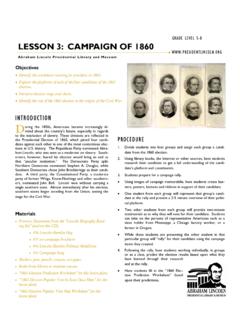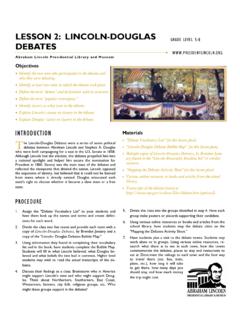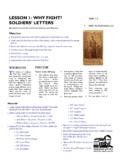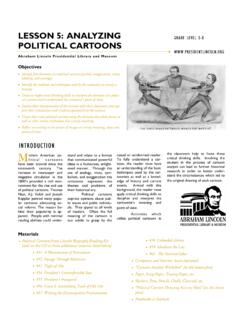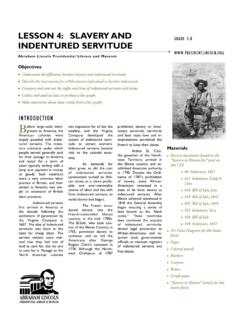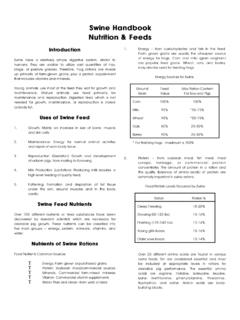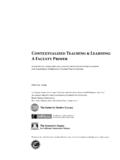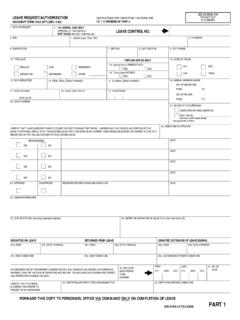Transcription of Lesson 2 Civil War Rations - Lincoln Log Cabin
1 Lacked variety and nutritional content. Often the food they ate was spoiled and the wa-ter contaminated, contribut-ing to nutritional problems and digestive ailments. A steady diet of hardtack and salt pork, and lack of fresh vegetables and fruits, led to scurvy and diarrhea. Two thirds of the deaths of Civil War soldiers were caused by disease. Unsound hygiene, dietary deficiencies, and bat-tle wounds set the stage for epidemic infection, while inadequate information about the cause of diseases hampered disease preven-tion, diagnosis, and treat-ment.
2 Pneumonia, typhoid, diarrhea/dysentery, and ma-laria were the predominant illnesses. D uring the American Civil War more than million soldiers served in the Union and Confederate armies. In order to feed so many troops, both govern-ments established a Commis-sary Department, in charge of coordinating food pro-curement, storage, and dis-tribution. Consequently, food rationing became a necessity. According to army regulations for daily camp Rations , a Union soldier was entitled to receive 12 oz of pork or bacon or 1 lb.
3 4 oz of salt or fresh beef; 1 lb. 6 oz of soft bread or flour or 1 lb. of hard bread (hardtack), or 4 oz of cornmeal. Salting, drying and pickling were common methods of pre-serving food in the 19th cen-tury. Meat issued to Civil War soldiers was usually salted while fruits and vege-tables were dried or canned. When marching, each soldier was responsible for his own food and was ordered to pack three days worth of Rations in his haversack.
4 Soldiers supplemented their diets by foraging and pur-chasing items from a sutler. The Confederate govern-ment adopted the official US Army ration at the start of the war, but was forced to reduce it as the war went on. Many Civil War soldiers suffered both imme-diate and permanent health problems because their diet INTRODUCTION Objectives Explore Civil War diseases, their causes, and treatment.
5 Understand the human body is affected by eating habits and per-sonal hygiene. Compare 19th century food preservation methods to 21st century. Recognize food borne disease is prevalent today and ways to prevent its spread. Correctly multiply and divide ration amounts and convert ounces into pounds. Abraham Lincoln Presidential Library and Museum Lesson 2: Civil WAR Rations GRADE 5-8 Materials Primary Documents from the Civil War Soldiers Kit (and on this CD) #25 Drawing of steers be-ing butchered #26 Drawing of a com-pany mess/Excerpt from letter of Hatch , July 30, 1861 #27 Marching ration #28 Soldeirs enjoying a meal Reproduction Artifacts found in the Civil War Soldier Kit (optional)
6 Internet 1 set measuring cups Pencils and Paper Online Resources Department of Health and Human Services Center for Disease Control and Prevention Civil War Food, Gettysburg National Military Park Civil War Soldier Life, Gettysburg National Military Park 1. Research and discuss vocabulary words associ-ated with this Lesson . 2. Have students examine the primary documents and artifacts from the Civil War Soldier Kit. 3. Read the excerpt of the letter from Hatch to his cousin Mason, July 30, 1861 aloud to class.
7 4. Write the Rations for 100 soldiers on the black-board. 5. Students will convert pounds to ounces then divide to determine what ration an individual sol-dier would receive. 6. Students will multiply that ration by three days to determine what a marching ration consisted of. 7. Have available a set of measuring cups to dem-onstrate various ration amounts. PROCEDURE 5. When did the health benefits of adequate sani-tation and hygiene be-come common place?
8 6. What food borne dis-eases are common in the 21st century? 7. Have there been any outbreaks of food borne diseases recently that you recall? 8. What kinds of proce-dures does the gov-ernment have in place today to prevent the spread of food borne disease? 9. Have you or anyone you know ever had a food borne illness? What were the symptoms? How long did it take to recuperate? DISUCUSSION 1. How would eating the same food items day after day affect you?
9 Describe how food Rations might have affected soldier morale. 2. What types of social problems could food rationing cause among soldiers? 3. What is scurvy? What causes the disease and how is it treated? Do we still have scurvy out-breaks today? 4. Many people around the world today survive on little food. What kinds of health problems occur from an insufficient diet? How does the daily ra-tion of a Civil War sol-dier compare with food portions today?
10 Page 2 Lesson 2: Civil WAR Rations Vocabulary ration Haversack Peck Desiccated Forage Hardtack Sutler food borne Scurvy Typhoid Malaria Civil War Rations For every 100 Rations there was issued: 1 peck of beans or peas; 10 lb. of rice or hominy; 10 lb. of green coffee or 8 lb. roasted cof-fee, or 1 lb. 8 oz of tea; 15 lb. of sugar; 2 qt. salt; 4 qt. vinegar, 4 oz. pepper, 1/2 bushel potatoes; 1 qt of molasses. In addition to, or as substitutes for other items, desiccated (dehydrated) vegeta-bles, dried fruit, pick-les, or pickled cab-bage might be issued.
